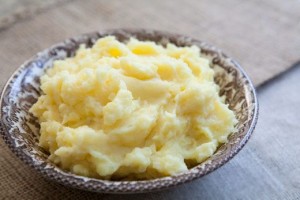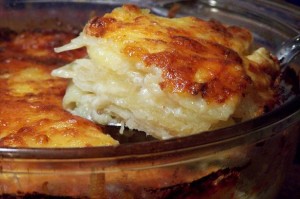Potatoes contain a lot of starch and for that reason they are extremely useful for thickening soups and other dishes. But it is important to pay attention to what kind of potato you choose for recipes because each type of potato has a different ratio of starch to moisture and each will behave differently when exposed to water and heat.
According to Cook’s Illustrated: the Science of Good Cooking, 2012, the starch content in potatoes can range from 16% to 22%. Less starch, and you get a firm, waxy potato, like the Red Bliss or French Fingerling. More starch such as in a Russet produces a crumbly, mealy texture. In the middle is Yukon Gold. Read more: http://forward.com/articles/14652/the-perfect-potato-/#ixzz2YkAt9zZJ
Russet potatoes are the best choice for mashing and for thickening. Add a grated Russet potato to any soup and you have added a natural thickener. Add a lot of potatoes and you can end up with an even thicker soap as in Vichyssoise (from earlier posts) or my father’s old fashioned potato soup. At the other end of the starch spectrum are Red Bliss. I boiled those and then removed their skins in a recent blog post. Fork-mashed with a bit of butter they were an easy and safe addition to a good meal.
Russets are better able to absorb liquid and they produce a fluffier potato when mashed. And mashed potatoes are true comfort foods. Most food cultures in countries where potatoes are grown have treasured comfort food recipes which can be adapted for individuals with swallowing disorders.
Here are some tips about cooking potatoes
- Start potatoes in cold water: it makes for speedier cooking time and better potato texture.
- Potatoes are best boiled in their skins because when they are are boiled whole and unpeeled, they absorb less water and can then absorb more cream and butter. Their potato flavor is much stronger, too, not washed out.
- Use a ricer or a food mill, both of which yield a much smoother mash than a potato masher.
- Stirring or using the food processor will manipulate texture for dishes that are meant to have a more sticky, tacky texture.
- Potatoes done in the food processor will be thick and gluey.
In conclusion: The method of handling your potatoes will affect the texture of your final dish. Pay careful attention to how much–or how little–you process them.
Classic Mashed Potatoes
Serves 4
2 pounds russet potatoes, cooked with the skins on
8 tablespoons unsalted butter, melted
1 cup half-and-half, warmed
salt and pepper
- Place potatoes in large saucepan and add cold water to cover by 1 inch. Bring to boil over high heat, reduce heat to medium low, and simmer until potatoes are just tender (paring knife can be slipped in and out of potatoes with little resistance) 20 to 30 minutes. Drain
- Set ricer or food mill over now empty saucepan. Using potholder (to hold potatoes) and paring knife, peel skins from potatoes. Working in batches, cut peeled potatoes into large chunks and press or mill into saucepan.
- Stir in butter until incorporated. Gently whisk in half-and-half, add 1 1/2 teaspoons salt, and season with pepper to taste. Serve
Add a cup of grated mild cheddar cheese and you have another taste
You could also cook potatoes in stock as in the following recipe
Potatoes in Chicken Stock with Mint and Butter
2 pounds russet potatoes
1 1/2 quarts chicken stock (I use Better than Bouillon)
2 fresh or dried bay leaves
1 bunch of fresh mint leaves
1 tablespoon coarse sea salt
2 tablespoons unsalted butter
- Scrub the potatoes, but do not peel. Halve them lengthwise. Place them in a two quart pan or casserole. Cover with the stock, the bay leaves, the bunch of mint, and the salt. Bring to a simmer over moderate heat and cook, covered, until cooked through when pierced with the tip of a knife, about 20 minutes. Drain and set aside. Discard the bay leaves and mint.
- When the potatoes have cooled, either peel them or push them through a food mill which will take off the skins.
- Add butter and beat vigorously with a wooden spoon.
- Serve immediately.
My mother’s scalloped potatoes
2 1/2 pounds Russet potatoes
2 tablespoons of lightly salted butter plus 1/2 stick
1 peeled clove of garlic
4 tablespoons flour
1/4 cup finely minced onions
1/2 stick of lightly salted cold butter
salt and pepper
1 cup whole milk, heated to warm, but not boiled
- Preheat oven to 350 degrees
- Generously butter a 2 1/2 quart casserole with 2 tablespoons of butter
- Rub the buttered casserole with the clove of garlic, then discard the garlic
- Peel the potatoes and slice into 1/16 inch slices (use a knife or a slicer or mandoline or the slicing disk on your food processor)
- Cut the butter into 1 tablespoon sections, using the paper wrapper as a guide, then cut each piece in four.
- Begin layering the potatoes in the casserole, sprinkling each layer with the minced onions, a teaspoon or so of the flour, salt and pepper, and dot with the small pieces of butter. Try for a least 3 layers.
- Pour the warmed milk over the layers of potatoes. Make sure the milk comes about 3/4 of the way up the side of the casserole.
- Put into the heated oven and bake 35 to 45 minutes
- Serve hot
You could add a cup of shredded cheddar cheese between the layers; don’t use Mozzarella as it’s likely to be stringy once heated and you want to avoid stringiness. In the picture on the left below, cheese has been sprinkled on the top of the casserole. Don’t do that as the browned topping may not form the cohesive bolus you want. Of course, you could always remove the top after baking so that you still get the flavor of having the cheese and the cheese will be in the body of the dish.




